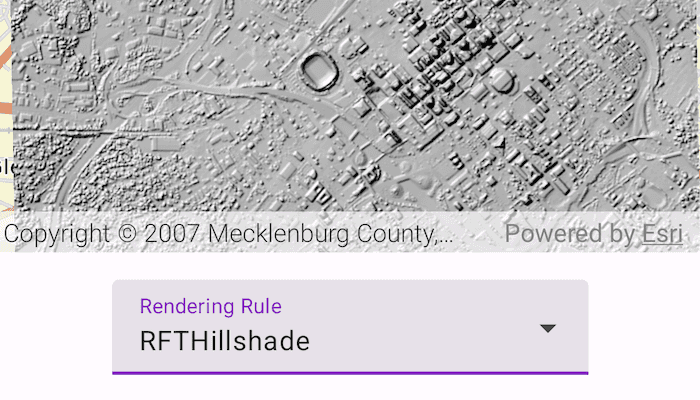Display a raster on a map and apply different rendering rules to that raster.

Use case
Raster images whose individual pixels represent elevation values can be rendered in a number of different ways, including representation of slope, aspect, hillshade, and shaded relief. Applying these different rendering rules to the same raster allows for a powerful visual analysis of the data. For example, a geologist could interrogate the raster image to map subtle geological features on a landscape, which may become apparent only through comparing the raster when rendered using several different rules.
How to use the sample
Open the sample and use the picker to select a rendering rule.
How it works
- Create an
ImageServiceRasterusing a URL to an online image service. - After loading the raster, get its
serviceInfoto get a list ofRenderingRuleInfosupported by the service. - Choose a rendering rule info to apply and use it to create a
RenderingRule. - Create a new
ImageServiceRasterusing the same image service URL. - Apply the rendering rule to the new raster.
- Create a
RasterLayerfrom the raster for display.
Relevant API
- ImageServiceRaster
- RasterLayer
- RenderingRule
About the data
The CharlotteLAS image service contains 9 LAS files covering Charlotte, North Carolina's downtown area. The LiDAR data was collected in 2007. Four raster rules are available for selection: None, RFTAspectColor, RFTHillshade, and RFTShadedReliefElevationColorRamp.
Additional information
Image service rasters of any type can have rendering rules applied to them; they need not necessarily be elevation rasters. See the list of raster function objects and syntax for rendering rules in the ArcGIS REST API documentation.
Tags
raster, rendering rules, visualization
Sample Code
/* Copyright 2025 Esri
*
* Licensed under the Apache License, Version 2.0 (the "License");
* you may not use this file except in compliance with the License.
* You may obtain a copy of the License at
*
* http://www.apache.org/licenses/LICENSE-2.0
*
* Unless required by applicable law or agreed to in writing, software
* distributed under the License is distributed on an "AS IS" BASIS,
* WITHOUT WARRANTIES OR CONDITIONS OF ANY KIND, either express or implied.
* See the License for the specific language governing permissions and
* limitations under the License.
*
*/
package com.esri.arcgismaps.sample.applyrasterrenderingrule.components
import android.app.Application
import androidx.lifecycle.AndroidViewModel
import androidx.lifecycle.viewModelScope
import com.arcgismaps.mapping.ArcGISMap
import com.arcgismaps.mapping.BasemapStyle
import com.arcgismaps.mapping.Viewpoint
import com.arcgismaps.mapping.layers.RasterLayer
import com.arcgismaps.raster.ImageServiceRaster
import com.arcgismaps.raster.RenderingRule
import com.arcgismaps.toolkit.geoviewcompose.MapViewProxy
import com.esri.arcgismaps.sample.sampleslib.components.MessageDialogViewModel
import kotlinx.coroutines.Dispatchers
import kotlinx.coroutines.flow.MutableStateFlow
import kotlinx.coroutines.flow.asStateFlow
import kotlinx.coroutines.launch
private const val IMAGE_SERVICE_URL = "https://sampleserver6.arcgisonline.com/arcgis/rest/services/CharlotteLAS/ImageServer"
class ApplyRasterRenderingRuleViewModel(app: Application) : AndroidViewModel(app) {
val mapViewProxy = MapViewProxy()
var arcGISMap = ArcGISMap(BasemapStyle.ArcGISStreets)
// List of raster layers, each with a different rendering rule
private val rasterLayers: MutableList<RasterLayer> = mutableListOf()
// List of rendering rule names for the dropdown
private val _renderingRuleNames = MutableStateFlow<List<String>>(emptyList())
val renderingRuleNames = _renderingRuleNames.asStateFlow()
// Currently selected rendering rule name
private val _selectedRenderingRuleName = MutableStateFlow("")
val selectedRenderingRuleName = _selectedRenderingRuleName.asStateFlow()
// Message dialog for error handling
val messageDialogVM = MessageDialogViewModel()
init {
viewModelScope.launch(Dispatchers.IO) {
createRasterLayers()
}
}
/**
* Loads the image service raster, gets all rendering rule infos, and creates a raster layer for each rule.
*/
private suspend fun createRasterLayers() {
// Create and load the base image service raster
val imageServiceRaster = ImageServiceRaster(IMAGE_SERVICE_URL)
imageServiceRaster.load().onFailure {
messageDialogVM.showMessageDialog(
title = "Failed to load image service raster",
description = it.message.toString()
)
return
}
val serviceInfo = imageServiceRaster.serviceInfo
// Check availability of rendering rule infos
val renderingRuleInfos = serviceInfo?.renderingRuleInfos ?: emptyList()
if (renderingRuleInfos.isEmpty()) {
messageDialogVM.showMessageDialog("No rendering rules found for this image service.")
return
}
val ruleNames = mutableListOf<String>()
// 'None' option: no rendering rule
val baseRaster = ImageServiceRaster(IMAGE_SERVICE_URL)
val baseLayer = RasterLayer(baseRaster).apply { name = "None" }
rasterLayers.add(baseLayer)
// For each rendering rule info, create a new raster layer
for (ruleInfo in renderingRuleInfos) {
val raster = ImageServiceRaster(IMAGE_SERVICE_URL)
raster.renderingRule = RenderingRule(ruleInfo)
val rasterLayer = RasterLayer(raster).apply { name = ruleInfo.name }
rasterLayers.add(rasterLayer)
ruleNames.add(ruleInfo.name)
}
// Load all raster layers
rasterLayers.forEach { layer ->
layer.load().onFailure {
messageDialogVM.showMessageDialog(
title = "Failed to load raster layer",
description = it.message.toString()
)
}
}
_renderingRuleNames.value = ruleNames
// Set initial selection to 'None'
_selectedRenderingRuleName.value = "None"
// Set the initial layer on the map
setRasterLayer("None")
}
/**
* Sets the raster layer with the given name as the only operational layer on the map.
* Zooms to the layer's extent if available.
*/
fun setRasterLayer(ruleName: String) {
val rasterLayer = rasterLayers.firstOrNull { it.name == ruleName }
if (rasterLayer != null) {
arcGISMap.operationalLayers.clear()
arcGISMap.operationalLayers.add(rasterLayer)
_selectedRenderingRuleName.value = ruleName
// Zoom to the raster layer's extent if available
viewModelScope.launch {
rasterLayer.fullExtent?.let { extent ->
mapViewProxy.setViewpoint(Viewpoint(extent))
}
}
}
}
}